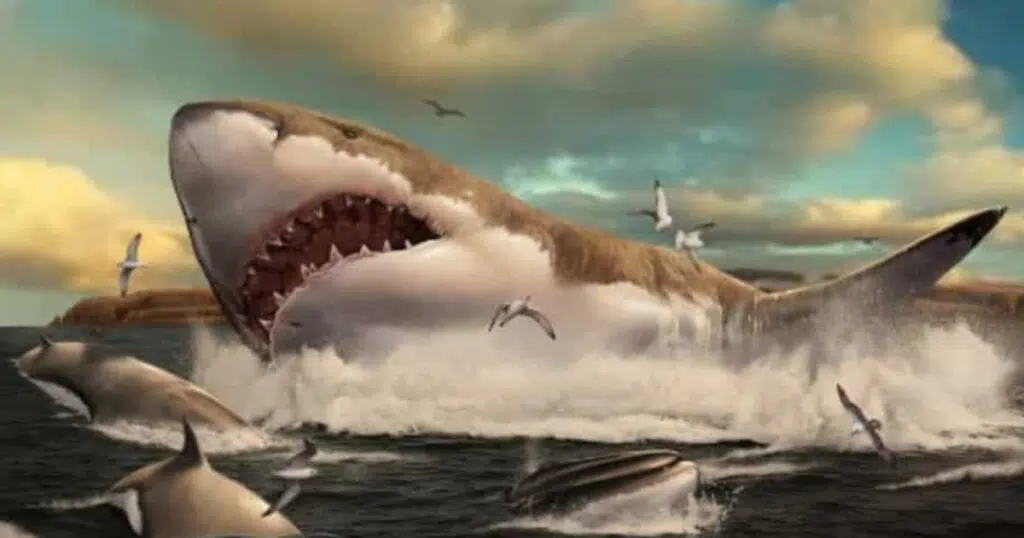
Researchers Get 3D Look at Body of Giant Shark Megalodon
Ever since American naturalist, geologist, and teacher Louis Agassiz announced its find in 1835, there’s been little doubt in the scientific community the Megalodon was the largest shark — largest fish of any kind — to swim Earth’s oceans.
But, aside from a collection of human-hand-sized teeth, there was little fossil evidence from which researchers over the years could extrapolate an accurate approximation of Megalodon’s entire body — until the recent advent of 3D computer modeling technology finally brought a truer representation of Megalodon to life.
“Shark teeth are common fossils because of their hard composition which allows them to remain well preserved,” explained first author Jack Cooper, a Ph.D. student at Swansea University. “However, their skeletons are made of cartilage, so they rarely fossilize. The Megalodon vertebral column from the Royal Belgian Institute of Natural Sciences is therefore a one-of-a-kind fossil.”
A team of International researchers, in collaboration with the University of Zurich in Switzerland, used an exceptionally preserved specimen from a single Megalodon discovered in the 1860s. A considerable portion of the creature’s vertebral column had ended up preserved to become part of the scarce fossil record after the specific Megalodon died in the Miocene oceans of Belgium about 18 million years ago.
The reconstructed Megadolon was about 16 meters (52.4 feet) long and weighed over 61 tons. It was estimated that it could swim at around 1.4 meters (4.7 feet) per second, require over 98,000 kilo calories (98-million standard calories) every day and have a stomach volume of almost 10,000 liters (2,641.7 gallons).
The 3D model suggested the Megalodon could travel long distances and was capable of eating whole prey of up to 8 meters (over 26 feet) long. The researchers determined with their new perspective the Megalodon could fully consume prey the size of today’s killer whales and then roam the seas without more food for two months.
Of particular note is the fact contemporary killer whales are considered today’s top ocean predator. Which means its ability to eat large dominant predators of comparable size millions of years ago places Megalodon at a much more elevated level in the ecosystem’s predatory hierarchy than modern top predators.
The research team, which included scientists from Switzerland, the United Kingdom, the United States of America, Australia and South Africa, first measured and scanned every single Megalodon vertebra, before reconstructing the entire column. Then they attached the column to a 3D scan from the U.S. of a Megalodon’s vertebral arrangement. They completed the model by adding “flesh” around the skeleton using a 3D-scan of the body of a great white shark from South Africa.
“Weight is one of the most important traits of any animal. For extinct animals we can estimate the body mass with modern 3D digital modelling methods and then establish the relationship between mass and other biological properties such as speed and energy usage,” said study co-author John Hutchinson, a professor at the Royal Veterinary College in the U.K.
The Megalodon’s need for a high-energy diet likely would have been met by feeding on calorie-rich blubber in whales, which showed evidence of Megalodon bite marks in the fossil record. “These results suggest that this giant shark was a trans-oceanic super-apex predator,” said Catalina Pimiento, a professor at the University of Zurich and senior author of the study.
The complete Megalodon model can now be used as a basis for future reconstructions and further research, according to the study. The new biological conclusions drawn from the investigation represent a leap in the knowledge of the singular super predator and helps to better understand the ecological function that mega-species play in marine ecosystems.
Said Pimiento: “The extinction of this iconic giant shark likely impacted global nutrient transport and released large cetaceans from a strong predatory pressure.”



